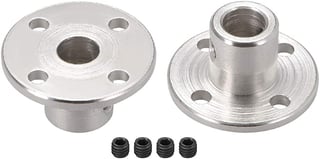I'm trying to drive an aluminium plate using a motor via a 20mm-wide 2mm-thick stainless steel tube. The tube is driven by a 6mm motor shaft via a pulley and the torque will be around 5Nm at most. Is it a good idea to attach the plate to the tube with a split collar like this?
However it's not clear what the rated torque and axial force are. If this isn't a good way, what might be an alternative without welding or adhesive?

